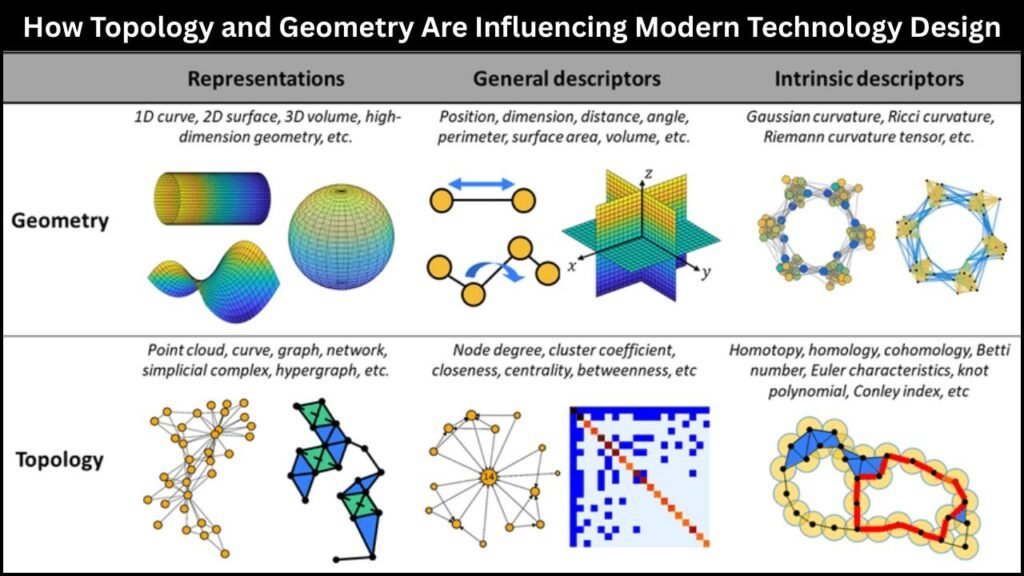
In the evolving world of science and technology, abstract concepts from mathematics often become the foundation for revolutionary innovations. Two such branches, topology and geometry, have moved beyond theoretical mathematics and are now playing pivotal roles in shaping modern technological design. From computer graphics to wearable devices, robotics to material science, these disciplines are helping engineers and scientists think outside the box, literally and symbolically.
Table of Contents
Understanding Topology and Geometry
Before diving into their impact, it’s important to understand what topology and geometry include.
Geometry is the study of shapes, sizes, and the properties of space. It deals with measurable quantities like angles, lengths, and areas. Geometry plays a central role in design, architecture, and mechanical systems.
Topology, on the other hand, is often described as “rubber-sheet geometry.” It is the study of properties that remain unchanged under continuous deformations such as stretching and bending, but not tearing or gluing. Topology focuses on the qualitative aspects of space, such as connectivity and continuity, rather than precise measurements.
Though distinct, both fields are increasingly intertwined and foundational to modern technological advancement.
1. Computer Graphics and 3D Modeling
One of the most visible influences of geometry and topology is in computer graphics and animation. Techniques like Bezier curves, NURBS (Non-Uniform Rational B-Splines), and mesh modeling are rooted in geometric principles. These are used to create realistic three-dimensional objects in video games, movies, and virtual simulations.
Meanwhile, topology optimization is used in generating efficient models that balance weight, strength, and structural integrity. This is especially important in gaming engines, where high performance must be balanced with visual fidelity. By manipulating surface topology, designers can reduce the computational load without sacrificing quality.
2. Robotics and Mechanical Engineering
In robotics, geometry is essential for movement and control. Robotic arms, for example, use geometric calculations to determine the angles and distances needed to perform specific tasks with precision.
Topology, however, has taken this further by influencing the development of soft robotics. Inspired by biological systems like octopus limbs or human muscles, soft robots are made using flexible materials. Topological principles help model how these robots move and interact with their environment, allowing for a new generation of machines that can perform delicate operations, like surgical procedures or navigating tight spaces.
3. Material Science and Metamaterials
Modern material science often draws heavily from topology. Researchers are now designing metamaterials, materials engineered to have properties not found in nature, using topological concepts. These materials can manipulate electromagnetic waves, sound, and heat in unusual ways.
For instance, topological insulators are a class of materials that conduct electricity on their surface but not through their interior. This property arises directly from the material’s topological characteristics. Such materials are promising for developing faster and more energy-efficient electronics.
Similarly, auxetic materials, which become thicker when stretched, exhibit normal behavior due to their geometric structure. They are being explored for use in protective gear, aerospace components, and biomedical devices.
4. Architecture and Product Design
Architects and designers have long used geometry in their work. However, topology has added a new dimension to creative freedom. Designs that once seemed impossible are now feasible thanks to parametric modeling software that incorporates both geometric and topological data.
Think of futuristic buildings with flowing curves, spirals, or holes, such structures are often born from topological transformations. These not only have aesthetic appeal but also practical benefits like improved airflow, structural efficiency, and sustainability.
In product design, especially for ergonomic gadgets and wearable technology, understanding the topology of the human body allows designers to create better-fitting, more comfortable products that enhance user experience.
5. Biotechnology and Medicine
Topology and geometry are revolutionizing biotechnology as well. Medical imaging, such as MRI and CT scans, relies on geometric algorithms to reconstruct images of the body in 3D.
More significantly, topological data analysis (TDA) is being used to understand complex biological systems. TDA helps in identifying patterns in high-dimensional data, such as genetic expressions or brain activity, that traditional methods might overlook.
In drug development and protein folding, topology helps in understanding how molecules interact and behave in various environments. This can lead to faster discovery of treatments and deeper insights into disease mechanisms.
6. Quantum Computing and Electronics
The next frontier in computing, quantum computing, is also rooted in topology. Topological quantum computing uses quasiparticles that encode information through their braiding and configuration in space. Because this information is resistant to local disturbances, it provides a more stable method for quantum calculations.
This innovation could overcome the errors that plague current quantum systems, making computations faster, more reliable, and ultimately, scalable for mainstream use.
In Summary
The merger of topology and geometry with technology is not just a marriage of math and machines, it is the blueprint for the future. By allowing designers and engineers to explore shapes, spaces, and connections in innovative ways, these mathematical disciplines are unlocking new possibilities across virtually every domain.
From creating lifelike digital worlds to designing next-generation materials, from decoding the secrets of biology to revolutionizing computing, topology and geometry are quietly but powerfully shaping our technological landscape. As technology grows increasingly complex, the abstract becomes the applicable, and the language of mathematics becomes the architecture of innovation.





